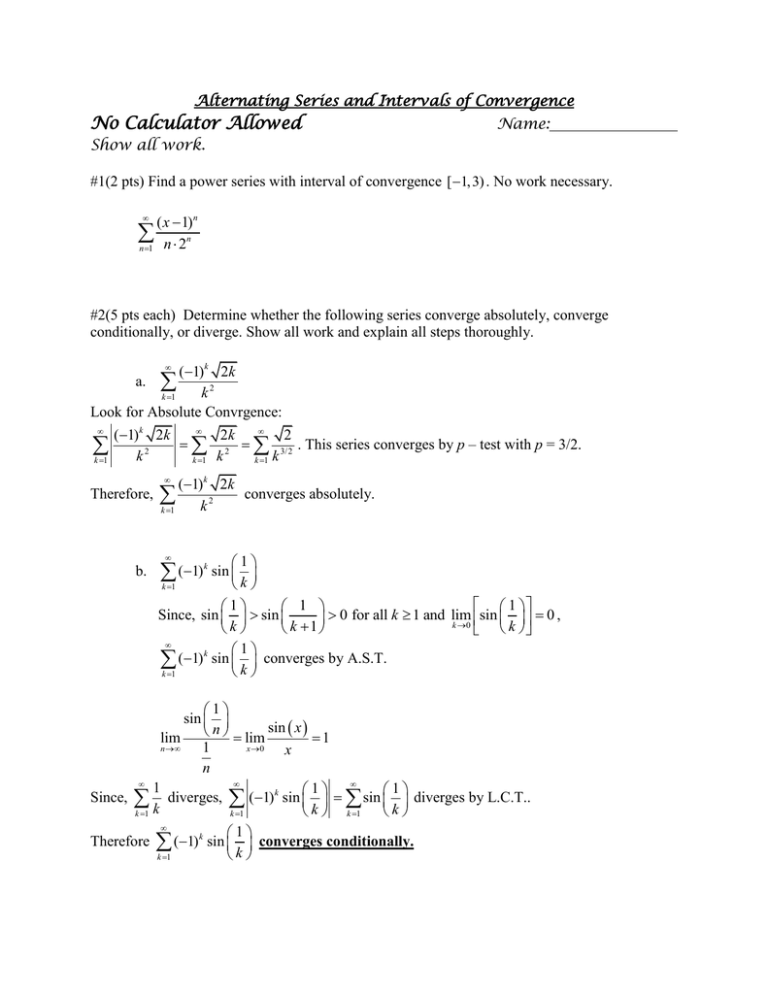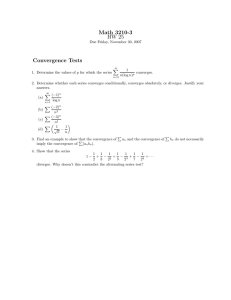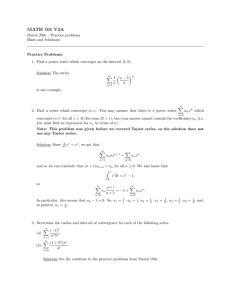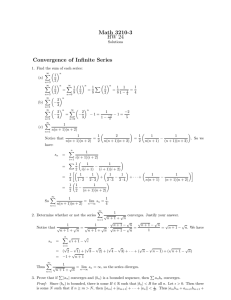Key am
advertisement

Alternating Series and Intervals of Convergence No Calculator Allowed Name: Show all work. #1(2 pts) Find a power series with interval of convergence [ 1, 3) . No work necessary. ( x 1)n n n 1 n 2 #2(5 pts each) Determine whether the following series converge absolutely, converge conditionally, or diverge. Show all work and explain all steps thoroughly. (1)k 2k k2 k 1 Look for Absolute Convrgence: a. k 1 (1) k 2k 2k 2 . This series converges by p – test with p = 3/2. 2 2 3/2 k k 1 k k 1 k (1)k 2k converges absolutely. k2 k 1 Therefore, b. 1 sin k k 1 1 1 1 Since, sin sin sin 0 , 0 for all k 1 and lim k 0 k k 1 k 1 (1) k sin converges by A.S.T. k k 1 (1) k 1 sin n lim sin x 1 lim n x 0 1 x n 1 1 1 Since, diverges, (1) k sin sin diverges by L.C.T.. k k 1 k k 1 k k 1 Therefore (1) k 1 k 1 sin converges conditionally. k #3(2 pts each) Given that S ( x) ak ( x 2) k converges for x 5 and diverges for x = 2 , k 1 determine whether each of the following statements must be true, may be true, or must be false. Give a brief explanation: a. The radius of convergence is S ( x ) is 5. This must be false. 3 R 4 . b. The series diverges at x 6 . This may be true. The interval of convergence may be (6, 2) or [6, 2) c. The interval of convergence for S(x) is [5,1] . This may be true. The center of the interval of convergence must be at x 2 , and since the series converges at 5, it may also converge at 1. d. The series converges absolutely on the interval ( 5,1) . This must be true. Since the series converges at x 5 , the interval of convergence must include at least [ 5,1) ; the series must converge absolutely on the interior of this interval. ln(k ) ( x 3)k . Show all k 2 2k k 1 #4(6 pts). Determine the interval of convergence of the power series work and explain all steps thoroughly. Absolute Ratio Test: ( x 3) k 1 ln(k 1) x 3 ln(k 1) k 2 2k k2 x 3 lim lim L k 2 k 1 k 2 k ( k 1) 2 ( x 3) ln( k ) 2 ln( k ) ( k 1) 2 x 3 1, then 1 x 5 So if 2 ln(k ) ( x 3)k ln(k ) (1) k Endpoints: x 1 which converges by A.S.T. k 2 2k k2 k 1 k 1 ln(k ) ( x 3)k ln(k ) x 5 2 . 2 k k 2 k 1 k 1 k Since 0 ln(k ) k 1 1 and converes, 2 2 3/2 3/2 k k k k 1 k Therefore the interval of convergence is [1,5] ln( k ) converges by C.T. 2 k 1 k (1)k 2k #5(5 pts). The series converges. If S 8 is used to approximate the value of this k2 k 1 series, will the error be less 0.01? Explain your analysis clearly. Since this is an alternating series with that S S8 a9 2(k 1) 2k 2k 0 and 2 0 as k , we know 2 2 k (k 1) k 29 3 2 2 2 .01 , we cannot be certain that S 8 is within . Since 2 27 (9) 81 27 .01 of S. #6(3 pts) Find the set of all x (1) k 3k converges. k 2 k 1 x k such that the series Let’s Use Absolute Ratio Test: (1)k 1 3k 1 x k k 2 3 k2 3 lim k 1 lim L 2 k k 2 k x k x ( k 1) (k 1) (1) 3 x 3 L 1 1 x 3 x 3 or x 3 . x (1) k 3k converges absolutely on (, 3) (3, ) and diverges on (3,3) . k 2 k 1 x k We now check x 3, 3 . So we know (1)k 3k 1 which converges by p-test. k 2 2 k 1 x k k 1 k (1)k 3k (1)k x 3 k 2 2 which converges absolutely by p-test. k 1 x k k 1 k x 3 Therefore, Convergence Set = (, 3] [3, )







